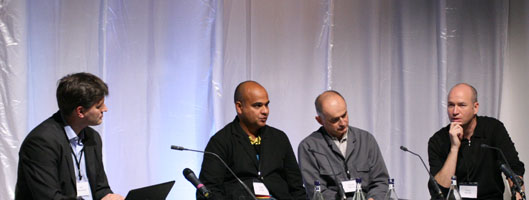Chair: Nico Macdonald
Daljit Singh (Digit London), Durell Bishop (Lucky Bite) & Andy Altmann (Why Not Associates)
Interaction design is a relatively young field, but already a very broad one. Its pioneers came from graphic and product design, architecure and programming backgrounds. Practioners design for different platforms including: the PC, mobile devices, the web and games; and a confusing vocabulary has emerged including: interface design, digital media design, service design and experience design.
What is the best way of understanding the discipline? Are interaction designers of different hues all essentially applying the same skills to different ends? If not what are the key distinctions?

Post-panel discusson
Comments from attendees can be found on the Interactions thread: Interaction blur post on the Intersections blog. If you attended the conference, please feel free to comment there yourself. if you write about a session in your own blog please ‘ping’ the TrackBack URL for the session post, so your post will also appear there for others to discover.
As well as the Report back (below), the podcasts are available on the School of Design site to download or stream, and the transcripts are available on the Design Council site. Read the transcript for this session.See also the related Digit London paper Moments.
The following notes are based on the report back given to the conference by Nico Macdonald. They may be updated once the podcast has been published:
Objectives/Challenges
Daljit: Advertising vs supplying information when relevant. Need something that make things simpler. Making technology invisible.
What is interaction design?
Durrell: Don’t want to make things invisible but to be able to see things. Lack of self-descriptive products. How do you visualise invisible systems? And manipulate them.
Andy: I don’t understand what interaction is. We interact with people all the time.
Skills
Durrell: Mobile phone UI designers need to know more about electronics.
Daljit: Looking for broader skills, eg: theatre designer or learning from (my experience of) making sausages [‘Bhangras’]
Andy: A new lease of life to get a drawing board again. (When left the Royal College they are what we started with.)
Andy: Need to learn one skill really well and understand rules/fundamentals.
Durrell: Skills are thought of as a way of implementing design, rather than thinking about things. Wanted to work on what products could do.
Tools
Durrell: Designersí tools not getting any better. Ways of getting involved are disappearing. To uncover the things underneath you do need to experience them. It is difficult to fluidly move from sketch into behaviour. The Processing tool [by Benjamin Fry and Casey Reas] doesn’t work in this respect. [Statement corrected post report back.] Need more tools that help you learn about what is around you.
Education
Can/should interaction design be taught?
Daljit: Teach design fundamentals: donít focus on a medium that hasnít yet grown up
Gus Desbarats [audience]: All designers should be interaction designers
Durrell: There is a reluctance by design courses to take on digital behaviour and [communications]. Teachers just need enough knowledge to get students excited. To uncover the things underneath you do need to experience them [ie: students also need to be taught by practitioners].
Andy: I need to re-teach students who come to us
Daljit: We have to [re-]train own people as skills change
Challenges
Durrell: There is a lack of interest by graphic designers in their tools [inc. user interfaces]
Andy: Graphic designers donít question user interfaces. Worry about how cool something is.
Durrell: With the iPhone, do you covet the interface or the object? [If it ran Windows Mobile would you like it as much?]
Future
Simple [visual/graphic] communication is necessary, and might take over from interaction design

